Networks have become the nervous system of the business. Applications are scattered across regions and clouds. Users sit everywhere. Traffic patterns shift by the hour. Yet most network teams are still expected to keep everything running with the same or fewer people, the same old dashboards, and a growing list of “critical” alerts.
At the same time, the talent pipeline is under real strain. According to research by Opengear, about a quarter of U.S. network engineers are preparing to retire in the coming years. This only deepens the gap between operational risk and available expertise. The result is familiar: slower investigations, longer outages, and hard choices about which issues to prioritise when everything looks urgent.
This is the context Kentik is speaking into with AI Advisor, its new agentic AI capability. Rather than simply adding another chatbot or visual layer on top of telemetry, AI Advisor is designed to take a natural language request from an engineer, understand the intent, build an investigation plan across Kentik’s network data, execute that plan using real tools, and present clear, transparent results.
In other words, AI Advisor is Kentik’s first agentic AI built to deeply understand and investigate networks in real time, turning intent into action on top of a trillion telemetry events each day.
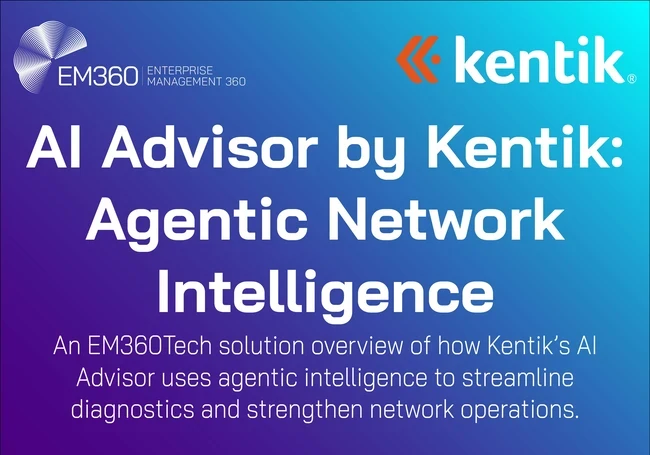
Why Networks Need Agentic Intelligence Now
Modern networks now operate at a scale and pace that strain traditional tools and workflows. Most enterprise environments no longer live in a single data centre. They stretch across private infrastructure, multiple clouds, software defined WANs, edge locations, and the public internet.
Each domain has its own telemetry, tools, and failure modes, which forces engineers to pivot between views and mentally stitch incidents together. That might be manageable for a minor issue on a quiet day. It becomes much harder when traffic is spiking, a rollout is in progress, and a key application is timing out for a major customer.
Agentic intelligence aims to restore network intelligence in this sprawl by connecting data sources, understanding how they relate, and driving investigations across the full path rather than a single device or link. At the same time, many network teams are running leaner than ever.
Experienced engineers are increasingly hard to replace, and the expertise required to troubleshoot complex environments is concentrated in a small number of people who are already stretched thin. As a result, mean time to resolution rises, change windows become riskier, and teams spend more energy defending the network than improving it.
Observability helped by making it easier to see what is happening across devices, flows, and services, but visibility alone no longer scales. Teams are overwhelmed by visualisations and alerts, and the work of deciding what matters still sits with a human.
Agentic AI shifts that burden by interpreting a question, planning the diagnostic workflow, running the checks, and returning a clear summary of what it found. And that’s the role AI Advisor is stepping into.
What AI Advisor by Kentik Actually Does
AI Advisor is built to take much of the manual effort out of investigation. Its capabilities become clearer when you look at how it moves from a simple request to a fully structured diagnostic workflow.
From natural language to diagnostic intent
AI Advisor starts with simple, text based interaction. An engineer might type a prompt such as “Show me interfaces with high packet loss in the last hour” or “Find security group misconfigurations that are blocking traffic to this subnet”.
The system takes that request and identifies the underlying task. Is this about application latency, DDoS behaviour, a routing issue, a cloud connectivity problem, or something else entirely? Once it has that intent, AI Advisor turns a plain language question into a concrete network investigation, selecting the right time windows, entities, and tools to query.

This natural language interface matters because it lowers the barrier to entry. Teams do not need to remember specific query syntaxes or jump through multiple pages. They describe what they need and let the agent handle the mechanics.
How the AI builds a plan and shows its reasoning
Once AI Advisor has a clear intent, it builds a multi step plan. That plan might include checking interface metrics, looking at traffic flows, inspecting BGP neighbours, or searching recent alerts and logs. Crucially, it does not hide this process.
Each response can include a reasoning pane that outlines the thinking behind the investigation. Engineers can see which tools were chosen, which filters were applied, and how the AI is linking different pieces of telemetry. That transparency is important for audit, trust, and training. It lets teams validate that the agent is looking in the right places rather than guessing in the dark.
Executing investigations using real network tools
AI Advisor is wired directly into Kentik’s underlying platform and Kentik Data Engine, which ingests around a trillion telemetry points per day across cloud, device, flow, and internet data. It can call a wide range of supported tools, including:
- Traffic and flow analysis in Data Explorer
- Network Management System metrics
- Device and interface inventory
- Cloud inventory and topology
- Syslog and SNMP trap search
- On demand ping and trace tests
As it runs these steps, AI Advisor streams progress into the conversation so engineers can see data and visualisations appear in place. It is important to note that AI Advisor is read-only. It does not make configuration changes or push updates to devices. Its role is to investigate, correlate, and advise, leaving final action under human control.
Context-aware operation inside the Kentik portal
AI Advisor is not limited to a single chat page. It runs inside the Kentik portal in several modes. In full-page mode, it takes over the screen for deep investigations. In overlay mode, it appears as a movable panel so engineers can keep working with dashboards while the conversation continues.
There is also an additional context mode. When someone opens AI Advisor from pages such as Devices or Alerting, the agent can automatically start with a prompt like “Troubleshoot this alert for me”, using the current device or incident as context. That context-aware operation turns AI Advisor into a companion that follows the engineer through their workflow rather than a separate destination.
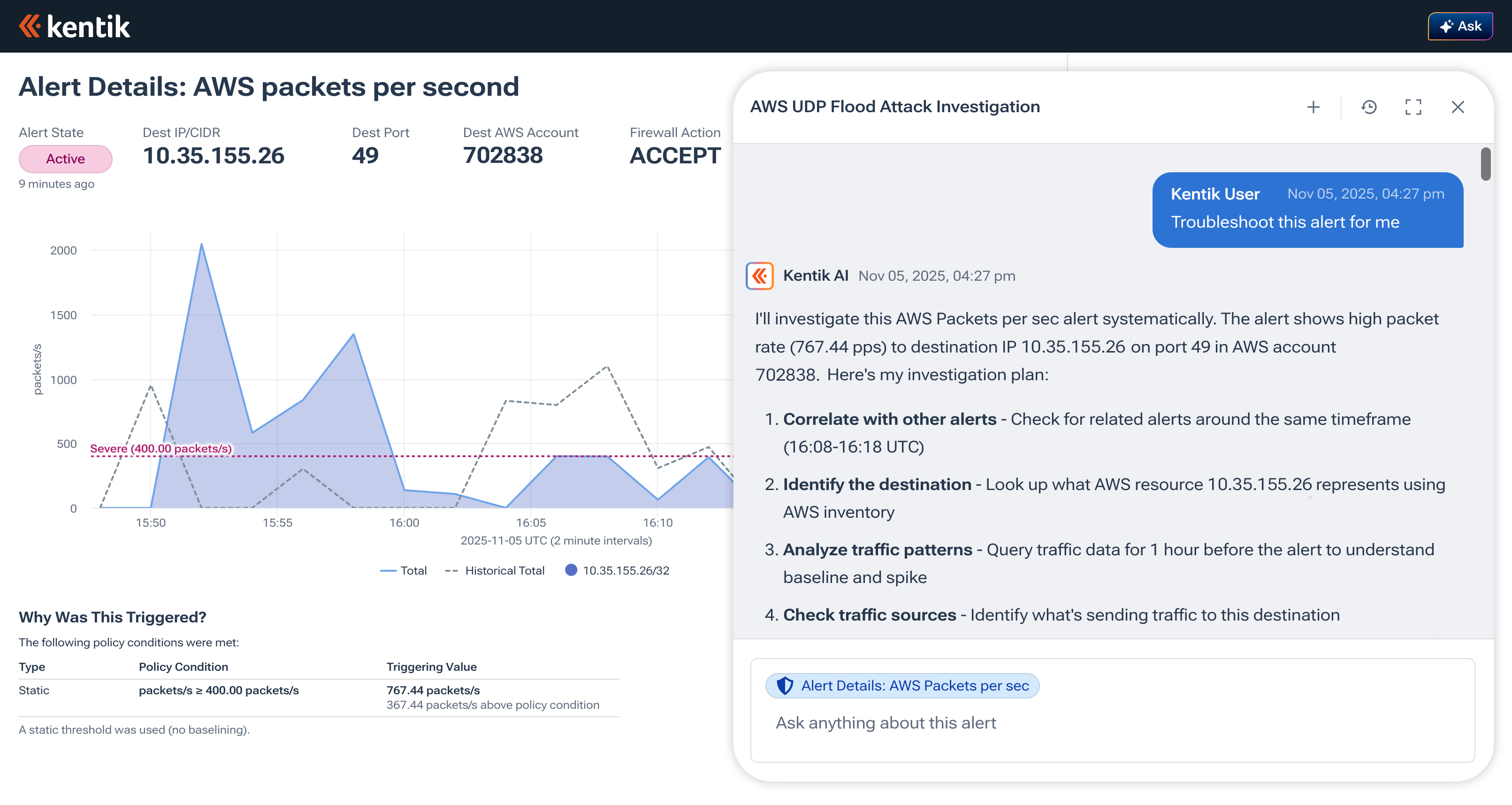
Key Features That Strengthen Network Operations
These capabilities translate into practical advantages for day-to-day operations. One of the most immediate is how AI Advisor accelerates the work of finding and understanding issues.
Rapid troubleshooting and root-cause analysis
AI Advisor is built to cut the time between noticing a problem and understanding why it is happening. An engineer who sees degraded application performance can ask for interfaces with high packet loss over a given period, then drill into affected BGP neighbours or flows with follow up questions.
Instead of crafting separate searches, they stay in one conversation while AI Advisor queries the right metrics and surfaces the patterns. By automating this AI driven investigation, the tool helps teams reduce MTTR and spend more time assessing options rather than hunting for basic evidence.
Multi-cloud visibility and architecture intelligence
Modern networks stretch deeply into AWS, Azure, and Google Cloud Platform. Keeping track of virtual private clouds, transit gateways, security groups, and peering relationships is a full-time job on its own.
AI Advisor can answer questions such as “Show me all VPCs in my AWS account and their connectivity” and then visualise that topology. Follow up prompts might ask for traffic between specific cloud environments or for potential peering candidates that would reduce cost or improve performance. This gives architects multi cloud visibility in a format that is easier to interrogate and share.
DDoS and incident investigation at scale
During a DDoS incident or large scale anomaly, speed and clarity matter. AI Advisor can correlate flow telemetry, device metrics, and alert data to highlight where traffic spikes are originating, which services or regions are affected, and how behaviour compares to past baselines.
By walking through the evidence inside a single conversational thread, the AI helps teams distinguish between background noise and true events, then move more quickly to mitigation using the tools they already rely on.
Consistent operations with Runbooks and Custom Network Context
Two capabilities give AI Advisor a deeper, more tailored view of each organisation.
Runbooks let teams define Markdown based recipes for specific alerts or scenarios. These can be attached to alert policies so that AI Advisor knows which steps to follow when a given condition fires. That improves consistency and reduces the chance of human error on a stressful call.
Custom Network Context allows up to 100 000 characters of organisation specific information, from naming conventions and IP schemes to maintenance windows and critical applications. AI Advisor uses this to interpret prompts and results in the language of the business, which is a key part of contextual intelligence.
Practical Use Cases for Network and Cloud Teams
These strengths become even clearer when applied to real operational situations. A common example is diagnosing sudden application slowdowns.
Scenario 1 – Application latency investigation
A support team receives complaints about slow performance from a key region. An engineer asks AI Advisor to show interfaces with high packet loss over the last hour, then follows up with questions about affected BGP neighbours and traffic spikes on specific interfaces. The agent pulls metrics and flows into a single conversation, helping the team isolate the problem path far faster than manual pivoting.
Scenario 2 – Cloud cost optimisation
Cloud spend climbs unexpectedly. A cloud architect asks AI Advisor for high-cost routes and interconnects between particular environments. The agent identifies heavy traffic paths and suggests potential peering or routing adjustments based on existing telemetry. That cost optimisation work, which once took multiple reports and exports, becomes a guided dialogue grounded in real data.
Scenario 3 – Capacity planning
Traffic volumes grow steadily across a set of backbone links. An engineer asks AI Advisor to forecast utilisation trends for the next quarter and highlight links projected to hit thresholds. With that view, the team can make more confident decisions about where to invest, which upgrades to schedule, and how to protect user experience as demand rises.
Final Thoughts: Agentic AI Is Reshaping Modern Network Operations
AI Advisor by Kentik is not a cosmetic overlay on existing dashboards. It is an agentic network intelligence capability that turns natural language intent into structured investigation across a rich, organisation aware data set. By combining runbooks, custom network context, and large scale telemetry, it helps teams diagnose faster, reason more clearly, and keep control of complex hybrid environments.
As networks continue to grow in reach and importance while senior engineers move on, tools that automate expertise rather than just tasks will define how resilient enterprises really are. Agentic AI will not replace human judgement, but it will increasingly shape how that judgement is applied.
For leaders assessing the next generation of network intelligence, EM360Tech will stay close to the vendors, patterns, and practices that show what effective, autonomous ready operations look like in the real world.

About Kentik
Kentik is a global network intelligence platform purpose-built for modern infrastructure teams. Founded by former network operators from Akamai, Netflix, YouTube and Cloudflare, Kentik combines vast-scale telemetry with AI-driven investigation and a unified view of cloud, device, flow and internet data.
Headquartered in San Francisco and operating worldwide, Kentik’s platform is trusted by enterprises and service providers to design, run and protect their networks with confidence, speed and clarity.
With support for hybrid-cloud, edge and on-premises environments, Kentik enables organisations to optimise performance, reduce cost, and strengthen resilience across the entire network fabric.
For more information, visit https://www.kentik.com


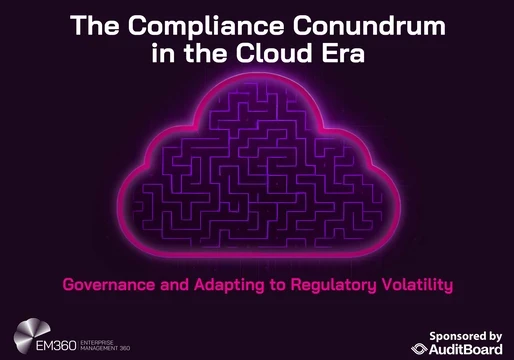

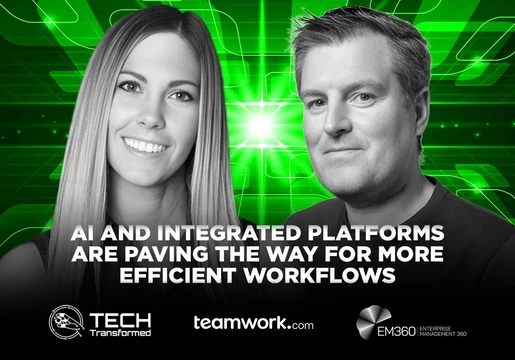

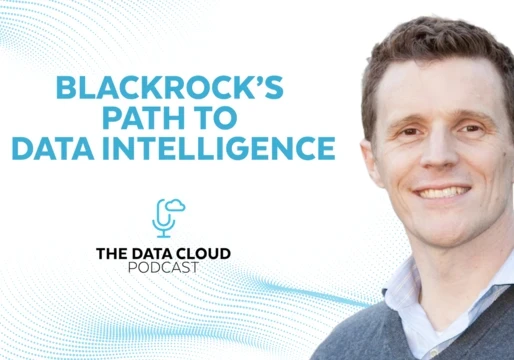
Comments ( 0 )